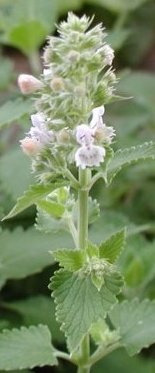Catnip - a designer drug for cats?

If you have a cat that has never been exposed to catnip, here's what will happen. Get some from your local pet shop, and spray a puff on the carpet. Your cat may ignore it, or sniff at it, or roll over it, kick at it, rub against it, and generally go nuts over it. No-one is quite sure why this happens, but it is generally agreed that the cat is not harmed by it. (Though it may be possible if you get your cat doing massive amounts of catnip - so don't.) In fact it is hard to get a cat to try excessive amounts of catnip because whatever causes the reaction only lasts a minute or two. Then the cat will ignore the catnip for several hours while something in its olefactory system resets itself. After that the cat may come back and get the same reaction.
So what is catnip? If it is a drug, there is nothing 'designer' about it - catnip is a herb which is native to Europe. It grows wild and under cultivation, and after being transported to the Americas it has become widespread as a weed. It is a member of the mint family, though it does not require as much moisture to grow does as mint itself. Once humans were quite fond of catnip too. Long before tea was imported from Asia, Europeans used to sit down to a good cup of catnip, in which the leaves were infused rather as camomile tea is today. Unlike cats, which find the stuff definitely stimulating, catnip is meant to have a mildly calming effect on humans. This is probably why it was originally cultivated in the Italian town of Nepete, from where it gets its scientific name (Nepeta cataria).
Humans are unable to tell what cats find so exciting about catnip as they are totally oblivious to the scent. (And it is the scent that gets them going. Cats which come across catnip plants may, well, er, nip, the leaves, but this is only because the nipping breaks open microscopic bulbs called trichomes, which releases the scent. A bug biting into the leaf or a large animal crushing the plant can have the same effect, but only on cats. Humans lack the olefactory (and possibly oral) receptors for nepetalactone, the active ingredient for producing feline freak-outs.

Other compounds which produce similar results in cats are actinidine, iridomyrmecin, and matatabilactone, which has caused some experts to speculate that catnip produces an intense version of some of the chemicals related to feline sex. This theory is strengthened by the fact that cats are generally insensitive to catnip until they are at least three months old - adolsecents, in terms of a cat's sexual maturity. Sensitivity to catnip tends to decline with age, but affects up to about half of all cats regardless of breed or gender. The other half of the feline population are probably left wondering what the fuss is all about. You can tell them it's genetic. If both of a cat's parents are insensitive to catnip, it will do nothing for her either. One catnip-sensitive parent gives a cat a 50-50 chance of inheriting the tendency.
If you fancy becoming a dope dealer for your cat, catnip is freely available from pet shops, but it can also be easily grown in your garden. The seed should be sown in rows about 20 inches apart. Give adequate sunlight and water, and that's it. Apart from weeding, your catnip bed will last several years, or until your cat finds that bruising the plant leaves releases a nepetalactone fix.
If you want to harvest a supply, collect the herb in mid- to late summer just before it flowers. Make sure that the leaves are not damp from dew or rain, and strip them from the stems as soon as possible. Drying them in an oven at a gentle heat of about 150 farenheight will preserve the oils and leave you with a good supply.
See also our video selections on 'Cats and Catnip'
